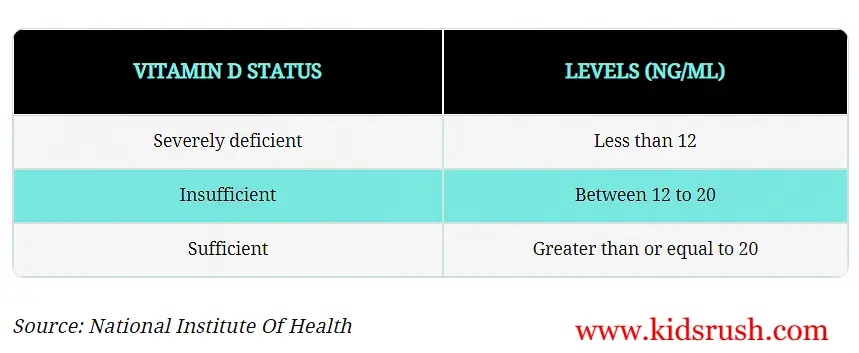Essential for bone mineralization, the immune system, and normal nerve and muscle function (1), vitamin D is a fat-soluble vitamin that has evolved into a hormone. Read this article at kidsrush.com to learn more about vitamin D deficiency and how it can affect children. Let’s start!
Dietary guidelines for American children (2010-2025) recommend 600 IU (15 mcg) of vitamin D for anyone between the ages of three and eighteen.
The American Academy of Pediatrics recommends that children receive their daily dose of vitamin D through sun exposure and food intakes, such as fortified milk and fish. But one out of every ten US children is believed to be vitamin deficient. (2)
The health effects of vitamin D deficiency in children include reduced quality of life and a higher risk of several health problems.
Related: Vitamins for Kids
Vitamin D Deficiency Signs and Symptoms in Children
Vitamin D deficiency is characterized by the symptoms that emerge when the body’s levels of vitamin D drop quite low. They might differ depending on the severity of the deficiency.
Vitamin D deficiency in children may manifest itself by several signs and symptoms including the following:
Tiredness and fatigue
Weakened bones and muscles and decreased vitamin D levels make individuals more vulnerable to fatigue. These symptoms resolve after supplemental vitamin D is given. (3). (4)
Pain in the muscles
Research suggests that vitamin D deficiency stimulates the sensory nerves that cause muscle pain. (5) Animal studies suggest that vitamin D deficiency triggers muscle pain by stimulating the pain-sensing nerves. (6)
Related: Causes of leg pain in children
Infections that occur frequently
Vitamin D deficiency can cause innate and acquired immune system impairment, therefore increasing the risk of autoimmunity (7). Individuals with enhanced autoimmunity are also at increased risk for infections, such as those that affect the respiratory tract. (8)
Wound healing
Vitamin D promotes wound healing through its essential anti-inflammatory properties. A clinical study found that vitamin D contributes to improved wound healing.
Bone loss
Deficiency in vitamin D results in decreased calcium absorption, which causes the bones and teeth to lose calcium. As a result of vitamin D deficiency, parathyroid hormone production skyrockets. As a result of decreased calcium absorption combined with increased bone loss, nutritional rickets occurs. Raising nutritional rickets impacts life quality by softening bones and the development of painful bone abnormalities.
Children of growing age sometimes develop bone loss or muscle weakness, which can severe reduce the ability to walk, play, and climb stairs.
Read Also: The Value of Vitamin E for Kids
Vitamin D Deficiency in Children: Possible Causes
Vitamin D deficiency in children could be caused by the following factors and conditions:
Nutritional deficiencies in vitamin D
The fortification of foods with vitamin D has become imperative because most foods do not contain vitamin D. However, many children, especially picky eaters, do not get the necessary amounts even from fortified foods, increasing the risk of vitamin D deficiencies.
Sunlight exposure
In children, the active vitamins D, also known as calcitriol, are created when the skin absorbs UVB (ultraviolet B) radiation, meaning 80 percent of the active vitamin D is obtained from sunlight. However, people who are usually indoors or whose skin is covered by sunscreen when playing outdoors are at increased risk of vitamin D deficiency.
You May Also Like: Iron Deficiency Anemia In Children
Cross-interactions between medicines
Several medications can reduce vitamin D levels, including steroids and anti-seizure drugs. If your child or teen is taking any medication, you should consult your healthcare provider. Particularly, if the child has insufficient or low vitamin D levels, they will suggest a supplement.
Physiological problems
Poor absorption of dietary vitamin D by the body can occur with conditions such as cystic fibrosis, inflammatory bowel diseases, and celiac disease. We may gradually develop vitamin D deficiencies with these conditions.
Diagnosis Of Vitamin D Deficiency In Children
Getting 25-hydroxy vitamin D levels measured in the body requires a blood test. The following chart represents vitamin D levels in nanograms/milliliters based on their serum levels.

How To Treat Vitamin D Deficiency In Children
The deficiency of vitamin D can be overcome through supplementation and treatment. A child will either be required to take vitamin D tablets or mixtures daily or once a week or once a month (high dose). Several factors determine the dosage of the drug, including the type of deficiency and the child’s overall health.
You should tell your doctor about any medications or multivitamins they are already taking for the child, so they can adjust the dosage proportionately. Additionally, they may suggest dietary changes including calcium-rich foods and 20 minutes of sunlight each day.
Vitamin D deficiency can lead to serious complications
Increased risk of the following conditions can be caused by untreated vitamin D deficiency:
- Hypocalcemia (low calcium)
- There is a low phosphate level known as hypophosphatemia.
- Softening of the bones (rickets)
- Poor physical development and growth
- A child with severe bone deformity limiting their movement
- Rheumatoid arthritis is a prevalent autoimmune illness.
Is there a way to prevent Vitamin D deficiency in children?
Vitamin D deficiency is not a consequence of excessive sun exposure or an unequal diet that contains foods containing calcium and vitamin D, such as vitamin D-fortified milk, dairy products, and dairy products.
Here are some foods that naturally contain vitamin D that do not contain fortifications:

In case you are uncertain about your child’s vitamin D supplements, consult a pediatrician who may give you a prescription for a supplementation program to combat vitamin D deficiency in your child.
Vitamin D deficiency affects growing children as well as other vulnerable populations. A child’s symptoms may include weakness, fatigue, and frequent infections, depending on the severity of his deficiency.
Getting adequate vitamin D levels and sunlight exposure can prevent vitamin D deficiency in children since the underlying disease can be prevented with timely vitamin D supplementation.
